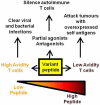Peptide Dose and/or Structure in Vaccines as a Determinant of T Cell Responses
- PMID: 26344744
- PMCID: PMC4494221
- DOI: 10.3390/vaccines2030537
Peptide Dose and/or Structure in Vaccines as a Determinant of T Cell Responses
Abstract
While T cells recognise the complex of peptide and major histocompatibility complex (MHC) at the cell surface, changes in the dose and/or structure of the peptide component can have profound effects on T cell activation and function. In addition, the repertoire of T cells capable of responding to any given peptide is variable, but broader than a single clone. Consequently, peptide parameters that affect the interaction between T cells and peptide/MHC have been shown to select particular T cell clones for expansion and this impacts on clearance of disease. T cells with high functional avidity are selected on low doses of peptide, while low avidity T cells are favoured in high peptide concentrations. Altering the structure of the peptide ligand can also influence the selection and function of peptide-specific T cell clones. In this review, we will explore the evidence that the choice of peptide dose or the structure of the peptide are critical parameters in an effective vaccine designed to activate T cells.
Keywords: T cell avidity; altered peptide ligands; functional avidity; peptide dose; peptide structure; peptide vaccines; vaccination.
Figures
Similar articles
-
A low antigen dose selectively promotes expansion of high-avidity autoreactive T cells with distinct phenotypic characteristics: a study of human autoreactive CD4+T cells specific for GAD65.Autoimmunity. 2010 Dec;43(8):573-82. doi: 10.3109/08916930903540424. Epub 2010 Apr 7. Autoimmunity. 2010. PMID: 20370569
-
Isolation of high avidity melanoma-reactive CTL from heterogeneous populations using peptide-MHC tetramers.J Immunol. 1999 Feb 15;162(4):2227-34. J Immunol. 1999. PMID: 9973498
-
Participation of L3T4 in T cell activation in the absence of class II major histocompatibility complex antigens. Inhibition by anti-L3T4 antibodies is a function both of epitope density and mode of presentation of anti-receptor antibody.J Immunol. 1987 Apr 15;138(8):2402-9. J Immunol. 1987. PMID: 2435798
-
Molecular mechanisms and biological significance of CTL avidity.Curr HIV Res. 2003 Jul;1(3):287-94. doi: 10.2174/1570162033485230. Curr HIV Res. 2003. PMID: 15046253 Review.
-
How the immune system achieves self-nonself discrimination during adaptive immunity.Adv Immunol. 2009;102:95-133. doi: 10.1016/S0065-2776(09)01202-4. Adv Immunol. 2009. PMID: 19477320 Review.
Cited by
-
Therapeutic Vaccine for Genital Herpes Simplex Virus-2 Infection: Findings From a Randomized Trial.J Infect Dis. 2017 Mar 15;215(6):856-864. doi: 10.1093/infdis/jix004. J Infect Dis. 2017. PMID: 28329211 Free PMC article. Clinical Trial.
-
Dose escalation study of a personalized peptide-based neoantigen vaccine (EVX-01) in patients with metastatic melanoma.J Immunother Cancer. 2024 May 23;12(5):e008817. doi: 10.1136/jitc-2024-008817. J Immunother Cancer. 2024. PMID: 38782542 Free PMC article.
-
Immune responses to a HSV-2 polynucleotide immunotherapy COR-1 in HSV-2 positive subjects: A randomized double blinded phase I/IIa trial.PLoS One. 2019 Dec 17;14(12):e0226320. doi: 10.1371/journal.pone.0226320. eCollection 2019. PLoS One. 2019. PMID: 31846475 Free PMC article. Clinical Trial.
-
Efficacy of FLU-v, a broad-spectrum influenza vaccine, in a randomized phase IIb human influenza challenge study.NPJ Vaccines. 2020 Mar 13;5(1):22. doi: 10.1038/s41541-020-0174-9. eCollection 2020. NPJ Vaccines. 2020. PMID: 32194999 Free PMC article.
-
Antigen presentation between T cells drives Th17 polarization under conditions of limiting antigen.Cell Rep. 2021 Mar 16;34(11):108861. doi: 10.1016/j.celrep.2021.108861. Cell Rep. 2021. PMID: 33730591 Free PMC article.
References
-
- Bachmann M.F., Kalinke U., Althage A., Freer G., Burkhart C., Roost H., Aguet M., Hengartner H., Zinkernagel R.M. The role of antibody concentration and avidity in antiviral protection. Science. 1997;276:2024–2027. - PubMed
Publication types
LinkOut - more resources
Full Text Sources
Other Literature Sources
Research Materials


